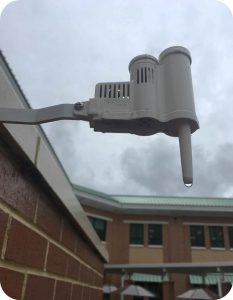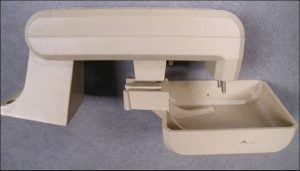Drip, drop, drip. I don’t know about you, but nothing quite hits the spot like an autumn rain. It can be the perfect setting for cozy socks, a good book, and a warm cup of tea. Not only does rain provide a soothing soundtrack for relaxation (and a good night’s sleep), but it also lets us ease up on our weekly watering duties. As Florida enters into its annual dry season, we need to think more consciously about our water use. Now is a great time to set your yard up for success by installing, replacing, or cleaning out your rain sensor.
Rain Sensor Statute
If you have an automated irrigation system (i.e. a sprinkler system that is set to go off certain times during the week), it is required by Florida state law that you also have a rain sensor.
“Any person who purchases and installs an automatic landscape irrigation system must properly install, maintain, and operate technology that inhibits or interrupts operation of the system during periods of sufficient moisture.” – Florida Statute 373.62
Now that you know the law requires an operating rain sensor, let us help you pick the best one for your lawn. Having a functional rain sensor is crucial to prevent overwatering. If too much water enters the soil before it can be absorbed by plant roots, the excess water may carry nutrients out of the soil, away from your lawn and gardens, and into nearby creeks and bays. Not only is this bad for local waters, but this also means that the plants in your landscape may not get the nutrients they need from the soil.
Nitrogen and phosphorus are two nutrients that can become mobile with excessive rain or irrigation. These nutrients enrich local waterbodies, contributing to harmful algal blooms and a list of other negative side effects. Installing and ensuring proper functioning of your rain sensor is paramount to the health of local aquatic ecosystems and your landscape’s soil.
Types of Rain Sensors
To prevent overwatering, rain sensors communicate to the irrigation system controller when sufficient rain has occurred. The controller then responds to the sensor by temporarily shutting off. Rain sensors truly come in all shapes and sizes. Each has a different mechanism of working, but they all perform the same function. Here are a few of the most common types.

The most common and arguably most efficient rain sensors are expanding cork-disc sensors. These devices come with a set of cork discs that expand when they soak up moisture. When there is a significant rain event, the disks expand to the point where they trigger a switch, which sends an electrical signal to the controller to stop irrigation. If your system is set to only water on your reserved watering day, you will not receive irrigation until that next designated point. Although these sensors are efficient, they do need to be checked and maintained regularly. For a handy guide on cork-disc rain sensor maintenance, visit this resource from the City of Tampa.

Another type of rain sensor is a weight-based rain shutoff device. As the name implies, this device operates by pausing irrigation when a certain amount of water is collected in a small, plastic dish. These rain sensors are relatively sturdy, though they can require more upkeep than other types. Particularly, debris may enter the collection cup and switch off the system. This may interfere with your scheduled irrigation, so it is important to do frequent checks.

The last type of rain sensor we are going to cover is the electrode type of rain sensor. These sensors rely on the electrical conductivity of water to communicate with your controller after a significant rain event. Rain collects in a dish, similar to the previously mentioned weight-based sensors. The system halts irrigation when the device’s metal probes touch the water. This device can also experience issues with debris in the collection basin, so be sure to clean it out as needed.
There are several rain sensors on the market, so we recommend that you conduct some preliminary research to see which brands and models hold up best over time. No matter your choice, be sure to perform yearly maintenance upon installation. This will keep your rain sensor communicating effectively with your controller.
Installation
Ready to install your new rain sensor? Keep reading for some tips and tricks to help you get the most out of your new device. First, be wary of where you install your device. Your rain sensor will work best in an open location where you would get a typical distribution of rainfall. Make sure there aren’t any trees or structures blocking the collection of water. After you figure out where to place your sensor, the next step involves connecting it to your controller. Installation may vary slightly depending on whether you have a wired or wireless sensor.

To begin, open up the face of your irrigation system controller. This should expose a number of wires connected to slots with various labels. Find the two slots with the label “SEN” or “RS.” There may already be a cable connected, so use a set of plyers or a screwdriver to remove it. For wired sensors, connect the two sensor wires to the now-empty slots on your controller. The order should not matter, but check your product’s instruction manual before proceeding.
Wireless sensors require a similar set-up, but you will be attaching the receiver box to the controller, not the sensor itself. The box will need to be mounted onto a flat surface. Depending on your product, you may need to use a drill with a screwdriver attachment. Wireless rain sensors allow you to have easier access to sensor controls through the receiver. This option is also great for those who would prefer more flexibility with their rain sensor location.
A working rain sensor can save you at least 2,000 gallons of water per year, which is enough to water a 1,000 sq ft yard for six weeks.
Resources and Opportunities
To read more about the use of rain sensors in automated irrigation systems, refer to the following EDIS document: Residential Irrigation System Rainfall Shutoff Devices, or Rain Sensors. You can also learn more about other types of rain shutoff devices in the Smart Irrigation Controllers series. Looking for even more content? Check out the Different Types of Rain Sensors presentation from Dr. Yilin Zhuang’s Water Wednesdays.
Residents of the City of Tampa can apply to receive a free rain sensor for any automatic irrigation systems with a timer. You can find more information and apply here.
There are so many more ways to save water with your irrigation system. Check out this table of water-saving behaviors for some inspiration and an estimate of how much you could be saving annually.
If you want to learn more about rain sensors and other ways to save water, register for our free, online Water Conservation in Sarasota County course by visiting the following link: https://bit.ly/waterconservationsc.
An Equal Opportunity Institution. UF/IFAS Extension, University of Florida, Institute of Food and Agricultural Sciences, Nick T. Place, dean for UF/IFAS Extension. Sarasota County prohibits discrimination in all services, programs or activities. View the complete policy at www.scgov.net/ADA.
 0
0
